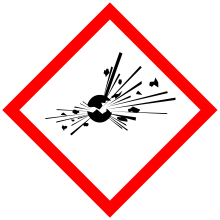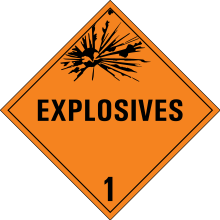Explosive



hazard symbol E (outdated EU label)
Explosives are solid and liquid substances as well as mixtures of substances which, when sufficiently energetically activated, go through a certain strong chemical reaction during which thermal energy and gases develop. When they react, explosives have a violent expanding effect that can cause considerable damage; improper handling can endanger life.
In the regulatory sense, substances must meet certain test criteria in order to be classified as explosive under hazardous substances law or in dangerous goods class 1 - explosives under transport law.
Basics
Explosives usually consist of chemical compounds or mixtures of substances that contain oxygen among other elements , which causes the combustible components of the molecule, i.e. the combustible components of the mixture, to oxidize at an enormous rate. This reaction is further characterized by the terms detonation , if the reaction speed is ABOVE the internal speed of sound and deflagration , if the reaction speed is BELOW the internal speed of sound. The rate of oxidation is one of the different factors that release the energy and gases for the explosion . In the composition of explosive substances, the available oxygen is mostly bound to nitrogen in nitro and nitrate groups or to chlorine in chlorates and perchlorates, the combustible components are almost always carbon and hydrogen , and in mixtures also sulfur , aluminum or zinc . Exceptions are, for example, azides , fulminates and tetrazene .
The probability that an explosive substance will ignite depends on its sensitivity to mechanical or thermal effects. Very sensitive explosives such as the initial explosives can only be produced and processed in small quantities at a time. Commercial explosives based on explosive oils and ammonium nitrate belong to the group of less sensitive explosives. Insensitive explosives such as ANC and weather explosives or cast TNT require a booster charge in addition to the detonator .
Classification
Classification according to use
Explosives are divided into:
- Initial explosives
- Pyrotechnics
- Explosives
- Propellants ( black powder , smokeless nitrocellulose powder (NC powder) and smokeless gunpowder )
- Ignition means
Classification of dangerousness
Explosives are as dangerous under ADR to the dangerous goods class 1 - Explosives classified, with subclasses 1.1 to 1.6, with the risk number 3 or 4. To qualify as hazardous substances apply to Explosive substances that shown above GHS symbol and depending on the particular property one of the following H-statements :
- H200 Unstable, explosive.
- H201 Explosive, risk of mass explosion.
- H202 explosive; high risk from splinters, explosives and thrown pieces.
- H203 explosive; Danger from fire, air pressure or splinters, explosives and thrown pieces.
- H204 Danger from fire or splinters, explosives and thrown pieces.
- H240 Heating may cause an explosion.
- H241 Heating may cause fire or explosion.
Characterization parameters
Oxygen balance : The oxygen balance indicates whether too much or too little oxygen is available for complete oxidation.
Normal gas volume : The normal gas volume (vapor volume) is the total volume of the gases resulting from the complete conversion of the explosive, based on normal conditions.
Explosion heat : The explosion heat is the thermal energy released during the explosion.
The work force of an explosive results from the heat of the explosion and normal gas volume.
The density is determined by customary methods. The term loading density is used for explosives , defined as the ratio of the weight of the explosive to the volume of the explosion space. The density can be varied for explosives of the same composition. A low density leads to an increased detonation capacity due to the larger internal surface and porosity, an increase in density with a decrease in the detonation capacity leads to increased explosiveness and explosive power.
The speed of detonation or burning speed is the speed in m / s at which the explosion in an explosive proceeds. It can range from a few m / s ( deflagration ) up to 10000 m / s. ( Detonation ) enough. Even today, it is partly determined by the Dautriche method. The explosive, which is trapped in a metal tube, is ignited and detonates detonators at two measuring points. These trigger the detonation of a detonating cord on both sides , the center of which is marked on a lead plate. The colliding detonation waves leave a notch on the lead plate. The detonation speed can be calculated from the known detonation speed of the detonating cord, the distance between the measuring points and the distance between the notch and the marking on the lead plate. There are electrical and optical measuring methods for more precise measurements.
The determination of the explosive force is based on comparison methods .
One possibility is to determine a lead block bulge according to Trauzl. In a lead cylinder 200 mm in diameter and 200 mm in height at the bottom of a bore 125 mm deep and 25 mm in diameter, 10 g of the explosive wrapped in tinfoil are detonated with a detonator with 2 g filling. Then the hole, which is dammed with quartz sand, is cleaned again, the bulging cavity is then used to assess the performance.
Another possibility is the ballistic mortar swinging out to the side, whereby the pendulum swing achieved serves as a measure of the explosive's performance.
The explosiveness (impact pressure) of an explosive as the product of density, specific explosion pressure and detonation speed is determined with the Kast apparatus in which a copper cylinder is compressed.
Impact sensitivity , friction sensitivity and the steel case test are criteria for the sensitivity of an explosive to mechanical and thermal stress.
Examples of the calculation
Calculation of the oxygen balance and the normal gas volume:
- Tetranitromethane
In addition to one mole of carbon dioxide and two moles of nitrogen, three moles of oxygen are released during the detonation. The mass of oxygen (3 x 2 x 15.9994) divided by the total molar mass (196.03) gives a positive oxygen balance of 49.0%. The gas volume is 6 moles per mole or 30.6 moles / kg. Multiplied by the normal gas constant of 22.414 l / mole results in a total volume of 686 l / kg.
- Ethylene glycol dinitrate
The detonation releases two moles of carbon dioxide, two moles of water vapor and one mole of nitrogen. Since oxygen is neither required nor released for complete oxidation, the oxygen balance is balanced and amounts to ± 0%. The gas volume is 5 moles per mole or 32.88 moles / kg. Multiplied by the normal gas constant of 22.414 l / mole results in a total volume of 737 l / kg.
In contrast, in the case of deflagration, the implementation is incomplete:
Instead of the 1020 kJ / mol in a detonation, only 293 kJ / mol are released.
- Trinitrotoluene
The detonation releases 3 moles of nitrogen. Due to the higher affinity , the hydrogen is completely oxidized to water vapor. The remaining oxygen is only enough to oxidize 7 moles of carbon to carbon monoxide. There remain 7 moles of carbon, which are not included in the gas volume calculation as a solid. The mass of the oxygen required for complete oxidation (5.25 · 2 · 15.9994) divided by the total molar mass (227.13) results in a negative oxygen balance of 74.0%. The gas volume is 7.5 moles per mole or 33.02 moles / kg. Multiplied by the normal gas constant of 22.414 l / mole results in a total volume of 740 l / kg.
use
For commercial and military use as explosives (eg. In the coal industry as a weather explosives , the construction of roads, tunnels, reservoirs, etc. as rock explosives), for geological purposes as seismic explosives than initiating explosives and detonating devices for triggering the detonation of less sensitive explosives, as propellants and projectiles for propelling projectiles, also as rocket propellants , also for the manufacture of pyrotechnic articles such as fireworks and the like.
history
The first documented account of the use of explosives comes from China in 1232. Around the middle of the 13th century, Roger Bacon and Albertus Magnus reported about black powder-like mixtures. The rediscovery of gunpowder is attributed to the legendary monk Berthold Schwarz , it was first used in the 2nd half of the 13th century to shoot arrow-shaped projectiles from closed tubes. The history of explosives in the subsequent period is closely linked to the development of guns and cannons from the 14th century. Black powder remained the only propellant for firearms until well into the 19th century . The use of black powder for commercial purposes began around 1620 with explosions in quarries and ore mines. The age of technical progress in the field of explosives began with the discovery of nitrocellulose and nitroglycerin in the middle of the 19th century. Their safe handling was only learned from around 1885. Important inventions in this field come from Alfred Nobel . In the period that followed, further explosives based on nitroaromatic compounds were developed. After the Second World War , the particularly safe and inexpensive ANC explosives and the water-containing explosive sludge were invented in the USA . The latest developments in this area are emulsions of mineral oil in concentrated aqueous ammonium nitrate solution.
Legal norms
The handling and use of explosives is regulated by a number of legal regulations and ordinances:
- Explosives Act (SprengG), Germany
- Guns and Explosives Act and Pyrotechnics Act , Austria
- Explosives Act (SprstG), Switzerland
- Ordinance on the Prevention of Accidents During Blasting Work , Liechtenstein
- Germany: ChemPrüfV § 2 Abs. 4
- Austria: Ordinance on Explosive Atmospheres (VEXAT)
See also
literature
- Josef Köhler, Rudolf Meyer, Axel Homburg: Explosivstoffe , Wiley-VCH, Weinheim 2008, ISBN 978-3-527-32009-7 .
- Jochen Gartz: From Greek fire to dynamite - a cultural history of explosives , Mittler, Hamburg 2007, ISBN 3-8132-0867-2 .
- Friedrich Trimborn: Explosivstofffabriken in Deutschland , Verlag Locher, Cologne 2002, 2nd edition, ISBN 3-930054-20-5 .
- Robert Matyas, Jiri Pachman: Primary Explosives . Springer, 2013, ISBN 978-3-642-28435-9 .
- SJ von Romocki: History of Explosives. Volume 1. History of explosives chemistry, blasting technology and torpedo use up to the beginning of the modern era, with an introduction by Max Jähns . Survival Press, (Berlin and) Radolfzell 1895, reprints Hildesheim 1976 and 1983, reprint 2003, ISBN 3-8330-0702-8 .
- SJ von Romocki: History of Explosives. Volume 2. The fumed powders in their development up to the present. Survival Press, Radolfzell 1896, Reprint 2004, ISBN 3-937933-00-X .
Web links
Individual evidence
- ↑ European Commission directive 92/69 / EEC, test method A.14 Explosive Properties.
- ^ UN Recommendations on the Transport of Dangerous Goods, Manual of Tests and Criteria, Fourth Revisited Edition 2003, United Nations Publication, New York and Geneva, ISBN 92-1-139087-7 .



